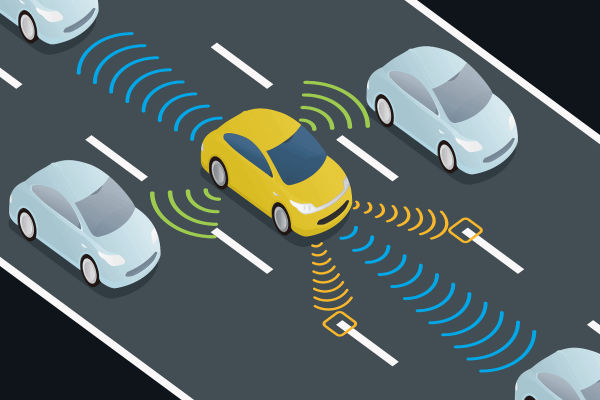The technological components of advanced driver-assistance systems (ADAS) increase vehicle safety. When constructed properly, these devices use a human-machine interface to improve a driver’s ability to adjust to traffic risks. These devices use automated systems and early warning systems to increase safety and response times to potential dangers. While aftermarket components and even whole systems can be added by manufacturers to tailor the vehicle for the driver, some of these systems are built into cars as standard equipment. Accidents involving cars are almost always the result of human mistake. By using contemporary driving assistance technology, one can avoid this (ADAS). In order to improve security and reaction times, automated alarm systems with possible early warning have given rise to ADAS technology. These technologies are intended to automate and enhance driving procedures in order to address human error and associated driving habits, which account for the majority of traffic accidents. These safety measures aim to lower the general frequency of traffic incidents, which will improve road safety and lessen casualties.
The Anxiety Towards ADAS
The goal of ADAS is to reduce the frequency and severity of car crashes that are unavoidable in order to reduce fatalities and injuries. Important information regarding traffic, road closures and blockages, congestion levels, suggested routes to avoid traffic, etc., may be obtained via these devices. These systems may also be used to monitor driving performance, provide advice, and detect human driver fatigue and attention. They can also be used to provide cautionary signs. When it comes to seeing danger, carrying out easy chores like cruise control, or difficult manoeuvres like overtaking and parking, these systems may take over from people.
Acquainting With Safety Features
The majority of cars on the road nowadays include basic safety features. You may be acquainted with lane departure warning systems, often known as blind-spot warning systems. These systems employ microcontrollers, sensors, and surveillance systems to relay indications of reflected objects ahead, to the side, and behind the automobile.
The popularity of automotive safety features has been greatly influenced by technological improvements and the spread of automated measures. Some examples of current systems that are available are as follows:
- Adaptive Cruise Controls (ACC)
- Brake Systems with Anti-Lock
- Forward Collision Alert
- High Beam Protection System
- Lane Departure Alert
Either a front stereovision camera or a single front camera is required for these ADAS functions. Occasionally, information from other devices is added to camera data, such as light detection and ranging (LIDAR).
One of the main driving forces for the growth of ADAS is the tightening global legislation governing car safety. These features, which include blind-spot detection, automated emergency braking, and adaptive cruise control, are becoming standard in new cars. Furthermore, the luxury vehicle industry, which frequently sets the standard for the adoption of cutting-edge technology, keeps integrating these systems at a faster rate to improve driver and passenger comfort and safety, according to Meticulous Research.
Market Challenges
There are a number of things barring the automotive advanced driver assistance system (ADAS) industry from getting the needed attention for growth.
Rules are still being developed, with an emphasis on infrastructural upgrades and safety requirements.
The high cost of upkeep and repairs for cars with ADAS is one of the key obstacles. Radar sensors are used by these advanced systems, which include features like Automatic Emergency Braking System (AEBS), Blind Spot Detection (BSD), and Adaptive Cruise Control (ACC).
The radar sensors for AEBS and ACC cost more than USD 900, while the rear radar sensors for BSD and rear cross-traffic warning cost over USD 2,000. These sensors require expensive repairs.
The radar sensors for AEBS and ACC cost more than USD 900, while the rear radar sensors for BSD and rear cross-traffic warning cost over USD 2,000. These sensors require expensive repairs.
Adoption of ADAS is significantly hampered by these high maintenance costs, especially in emerging nations where consumers are price conscious. The lack of qualified personnel needed to calibrate and fix ADAS equipment is another difficulty.
There are still issues that need to be resolved, such as the integration of technologies like Automotive Ethernet, high-definition cameras, and sensors (radar, LIDAR, ultrasonic, image, and infrared) with human-machine interfaces, as well as the requirement for standardized infrastructure in rural and less developed regions.
Indian Raging Roads and the Growth of ADAS
For ADAS systems, driving in India is a difficult problem. Indian roadways are frequently chaotic, in contrast to wealthy nations with well-marked routes and predictable traffic patterns. Pedestrians flowing across traffic, stray animals, unmarked lanes, and unpredictable driving patterns can all confound ADAS sensors and perhaps cause misinterpretations. When a cow crosses the road, for example, an automobile equipped with AEB may suddenly apply the brakes, resulting in a rear-end accident. Similarly, if there aren’t any obvious lane markers, lane departure alerts may constantly ring. In 2023, an Indian study found that more than half of the participants thought these issues contributed to the restricted usage of ADAS in India.
The infrastructure on Indian Roads is not yet ready to accommodate the broad use of ADAS systems. For instance, lane lines and traffic signs are often absent from Indian roadways, which might hinder the efficiency of ADAS systems. Inadequate infrastructure can restrict the usefulness of ADAS systems and discourage users from implementing them.
The complicated regulatory framework governing the Indian automobile industry might make it difficult for ADAS technology to be developed and used. For instance, the kinds of ADAS technology that may be installed in Indian cars may be restricted by laws pertaining to emissions and vehicle safety.
Key Initiatives By Indian Government To Complement ADAS
The Indian government has put in place a number of programs and laws to encourage the use of electric cars and raise standards for automotive safety. For example, the Bharat New Vehicle Safety Assessment Program (BNVSAP) establishes safety requirements for new cars, including the need for certain ADAS features, while the Faster Adoption and Manufacturing of Electric cars (FAME) plan offers incentives for the purchase of electric vehicles.

















